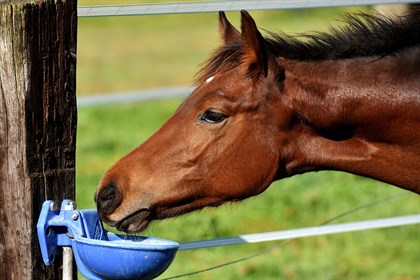|
This article has appeared previously with Equestrian Life. To see what's in our latest issue, click here.
  
HELPING THE SLOW OR BACKWARD YEARLING FULFIL POTENTIAL
By Dr J H Stewart BVSc BSc PhD MRCVS Dip BEP AAIM Equine Veterinarian and Consulting Nutritionist
As the young horse approaches the yearling stage, additional nutritional support can assist the ‘backward’ youngster in reaching their growth potential. To achieve significant gains without inducing growth abnormalities requires attention to detail and fine-tuning of the exercise–nutrition balance. Alternately feared and revered, protein is part of the bigger picture of conditioning/nutritional protocols that result in specific changes in body composition. The word protein comes from the Greek word ‘protos’, meaning ‘first’, because protein is the primary basic constituent of all living cells. Protein makes up 3/4 of the dry weight of most living cells, provides the building blocks for muscle and bone and is intricately involved in the formation of hormones, enzymes, antibodies and immunity. The building blocks for protein are the amino acids. Necessary for muscle growth and repair, strong tendons, increasing bone density, joint health, hoof wall thickness and overall strength and soundness is the interaction of vitamins and minerals with amino acids.
To appreciate how much the young growing horse depends on receiving the correct amino acids in the diet, is to be aware of how dynamic the equine system is. Every second the bone marrow makes millions of red blood cells; every four days the blood platelets and most of the lining of the gastrointestinal tract are replaced; every 10 days, most of the white blood cells are replaced and the demand for raw materials by the developing musculo-skeletal system is huge.Skin and coat health, reproductive efficiency, resistance to disease, ability to tolerate hard work, recovery from injury and illness and whether a young growing horse deposits fat instead of building muscle and bone, all depend on the quality and quantity of protein in the diet.
Protein is made of amino acids, joined together in long chains. Every protein in nature, whether plant or animal, is made to a precise and specific recipe – having its own particular arrangement or sequence of amino acids.

Horses receive amino acids from the protein in both concentrates and hay. Every protein source has a different combination of amino acids. Some combinations are very good and some not so good. For this reason, the total protein of horse feed is a worthless term, unless you know the amino acid profile. For example, the feed tag might say 14% crude protein, but to the horse, if all the amino acids are not supplied, it may be only 8 or 9% usable protein. The more unusable protein the horse consumes the more they have to excrete. This has been linked in both human and veterinary medicine, to reduced bone density. The feeding of unusable protein is the equivalent in terms of metabolic stress, to the feeding of excess protein.
Horses require a certain number of grams of protein a day, not a percent. Knowing the interest rate of a financial investment will not reveal the return until % interest is multiplied by the amount invested. Similarly, comparing the percent protein of different feeds is a futile exercise unless the weight of feed is factored in. If for example, a feed is 10% protein and a horse is fed 3 kg of the feed – the horse receives 300 g of protein. If another feed is 20% protein and a horse eats 1.5 kg, it still receives 300 g of protein. So it is meaningless to compare feeds on % protein alone. In addition, the dietary protein must contain the 10 essential amino acids.
The quality of any feed is determined by the number and amount of each of the 10 essential amino acids. Picture a wooden water barrel – or if you prefer, a wine or beer barrel! The barrel can only hold water, wine or beer to the level of the shortest slat. Now, think of each wooden slat as an essential amino acid. For growth to occur in a synchronised way, the creation of new cells is a priority. If just one amino acid in the profile is missing the creation of new cells stops.

Regardless of the % protein of a feed, if there is not enough of each essential amino acid, a limit to protein synthesis is set; the other essential amino acids cannot be used and are degraded and stored as fat. When this occurs, horses will lay down ‘cover’ (fat) instead of building muscle, blood and bone. Muscle building is so specific that if the feed meets required levels of 9 essential amino acids, but has only half of the tenth, body protein synthesis (i.e. Muscle and bone development) will be reduced by up to 50%.
Protein in general should never be fed in excess to any horse. Neither should there be an overload of protein types that are poorly digested nor protein that the horse cannot use. Essential amino acid deficiencies can occur even on diets containing excess protein and deficiencies cannot be corrected by feeding more of the wrong ‘type’ of protein.
The horse requires a precise number and balance of amino acids. Essential amino acids cannot be synthesised by the horse’s system and are so-called, because it is essential that they receive them every day in the feed. The exclusion or a deficiency of even one essential amino acid from the diet will reduce total body protein synthesis.Horses do not grow only in weight and height – specific tissues have specific periods of maximum development. Maximum bone growth occurs from 3 months before until around 9 months after birth and maximum muscle development takes place between 2 and 22 months of age. If bone and joint development have been protected by careful attention to the diet and exercise during the pre-natal, foal and weanling stages, at 10 to 12 months of age, increasing growth can be achieved with greater safety.
These growth periods provide the opportunity for determining body composition. By 10 to 12 months of age, the major risk periods for hock and stifle OCD are over and it is now possible to ‘ask’ for more growth without facing the risks of developmental orthopaedic diseases.
Correctly fed yearlings achieve greater gains in wither height, reach mature height earlier and deposit less fat because their essential amino acid requirements are met. Two horses may be gaining similar amounts of weight, but one may be building body, bone and lean muscle mass and another depositing fat. Although weight and height measure growth, they are not sensitive enough to reveal the effects of lowered amino acid absorption on skeletal or muscle development. Analyses of diets of yearlings that are laying down too much cover – instead of gaining in height and muscle development – have revealed essential amino acid deficiency. A close watch must be kept on weekly weight gain as well as height.
Extensive trials on the micro-management of amino acid intake in backward yearlings show profound results. When fed a supplement formulated to contain the exact same profile and combination of amino acids that is present in equine muscle and bone, the yearlings had significant increases in growth parameters. Of enormous practical significance for those responsible for guiding growth and development of the yearling, were the following findings:
1. weekly body weight gains were higher than in unsupplemented yearlings
2. body condition scores remained the same
3. height increase and cannon bone circumference were significantly greater than in unsupplemented yearlings
What these results demonstrate is that with the provision of protein profiled specifically for horses, backward yearlings made significant advances in height and that the increases in body weight and condition reflected increased bone and muscle development – not increased fat cover. In other words, correcting and boosting amino acid intake favoured the development of a more athletic youngster and supported the achievement of growth potential in slow and backward yearlings.
READ THE LATEST NEWS ARTICLES HERE

|

